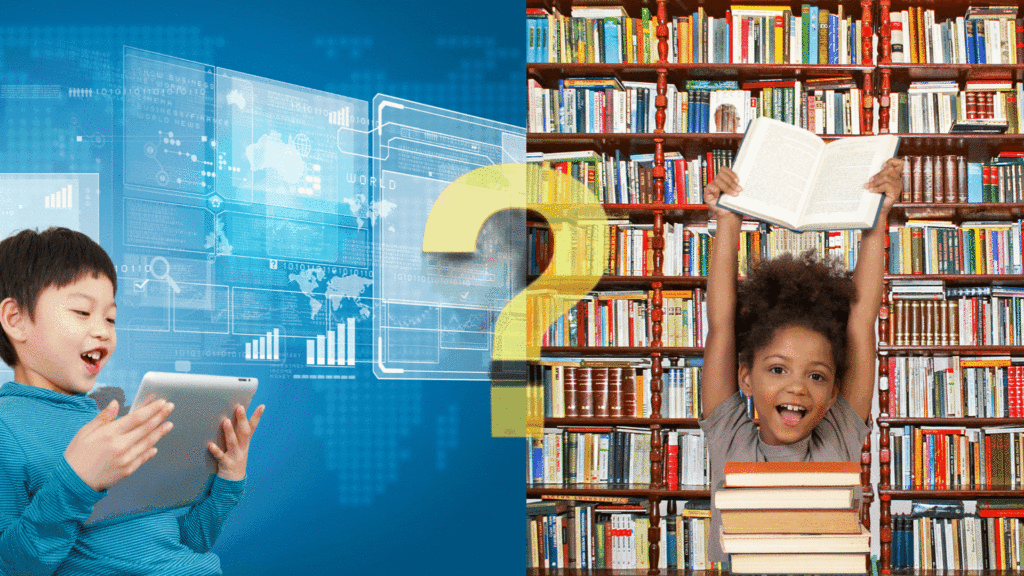Celebrating the joys of both traditional and technological reading methods to enhance student literacy.This post will explore the role of technology and its place in the role of reading instruction in the digital age,, including its advantages, best practices, and common concerns. I will provide a roadmap of how technology can be leveraged to improve reading instruction and help children with the complex skill of decoding and making meaning from text, or in other words, how tech can help your child learn to read. As we explore the latest research and examples of successful tech-boosted reading programs, I hope you will find valuable tips and tricks to guide your children, or your students, to improve their reading skills.

Overview of the importance of reading in the digital age:
Reading is a fundamental life skill that enables individuals to access information, express themselves, and navigate the world around them. Being a strong reader and thinker in the 21st century is crucial. If children do not get a strong start in decoding and comprehension skills they will be at a significant disadvantage in the future. Effective reading instruction plays a crucial role in helping students develop the skills and strategies they need to become confident, competent readers. It is through reading instruction that students learn the foundation of literacy, including decoding, comprehension, vocabulary, and critical thinking skills.
Stay current with Tech
As children are evolving, connecting, and learning science, geography, math, and reading in the digital age, technology is evolving along with them. It has become a much more important tool in reading instruction than it was even 3 years ago. With the rapid growth in the AI sector, you can bet that ed-tech will also have rapid growth. Your children will grow up in an entirely different way than they did before 2023, and it is important to stay up to date so that you can assist, monitor and engage with the technology that is at their fingertips. . With advancements in tech, students have a wealth of information quite literally at their fingertips. The way in which we learn and communicate changes in an instant. Parents and educators can ensure that students have the skills and knowledge they need to succeed in the 21st century.
The Advantages of Technology in the Instruction of Reading in the Digital Age
Personalization of reading materials:
A reading lesson with tech involved is a reading lesson that is fun. Fun means more engagement, and that means more learning. With technology, kids can pick books that are just their level and that they really like. This makes reading a personal experience that’s just right for each student. The books also often have cool tools like text-to-speech, definitions for big words, and quizzes to see if they understand what they read. By picking books that are a bit challenging, but still make sense and are enjoyable, kids can get better at reading while also having a good time. It’s a win-win situation! For an example check out www.readworks.org. I use this mostly free website with my students almost every day, they love it!
Improved access to a wider range of reading materials:
Kids that use tech can get access to more information than they will ever actually need to know. With technology, students can find all sorts of books, articles, and videos from all over the world. This gives kids a chance to learn about different perspectives, cultures, and ways of thinking. It also helps them develop a love of reading and learning that will last a lifetime! I love the National Geographic Kids website with its diverse and engaging content, check it out.
Enhanced engagement and motivation for reading:

As noted earlier, interactive reading materials, games, and videos can make reading more fun and engaging for students, encouraging them to spend more time reading and improving their literacy skills. educators can help students see the value and relevance of reading in their daily lives if they incorporate tech into reading instruction. Reading becomes relevant.
Real-time feedback and progress tracking:
Technology can also help teachers keep track of how students are doing and give them feedback. With digital tools, teachers can see how well kids are doing, what they’re good at, and what they need help with. This way, teachers can give kids the right kind of support to help them do their best. This type of feedback and tracking can make kids more motivated and successful in reading.
Best Practices for Integrating Technology when Reading in the Digital Age
Purposeful and strategic use of technology:
When integrating technology into reading instruction, use technology purposefully and strategically. Choosing technology that supports the learning objectives, instructional strategies, and assessment methods being used is important. Also, be mindful of the amount and type of technology being used, to ensure that it supports student learning and does not distract from it. This can be trickier than you think. Pay attention to what kids are doing and regularly check in to make sure the desired skill set is actually remaining in their brains. The Kindle Fire for Kids is a great product to encourage reading in children. The child-friendly protective cases and 2-year worry-free guarantee make it a secure and practical option for parents. Additionally, the tablet comes with features such as parental controls, content filtering, and educational apps and games that can help children develop their literacy skills. Technology can be a valuable tool in helping children learn and develop, and the Kindle Fire for Kids is a great example of how technology can be used to support educational goals.
Balancing digital and traditional reading materials:
Reading in the digital age comes with a balance between both digital and traditional reading materials. It’s important to remember that a balanced reading experience is key. While technology can give students access to a lot of information, it’s still important for them to read traditional materials like books, newspapers, and magazines. This helps students have a well-rounded reading experience and understand the value of different types of text.
Building digital literacy skills:
Incorporating technology into reading instruction can bring many benefits, but it’s also very important to build strong digital literacy skills. into your tech program. Students need to learn crucial skills such as evaluating information and sources critically, maintaining privacy and security online, and using technology responsibly to support their learning and growth. Developing these skills equips students to navigate the digital world and make informed decisions in their reading and learning experiences. And it could save their life. Cyber Bullying is a real thing, arm your kids with the right knowledge to keep them safe and protected online.
Collaborative learning opportunities:
Finally, ed-tech can be used to support collaborative learning opportunities in reading instruction. With digital tools, students can engage in virtual discussions, peer review, and collaborative writing activities, helping to develop critical thinking, communication, and teamwork skills. Collaborative learning activities also promote student engagement and motivation, as students are able to connect and learn from one another. Collaboration is a key skill in 21st Century thinking and is one of the main qualities that companies look at when hiring new employees.
I hope that you found some helpful information in this blog. Check out this blog post where I talk about how to help your kids build resilience as they navigate the exciting yet challenging landscape of the world we all live in.

